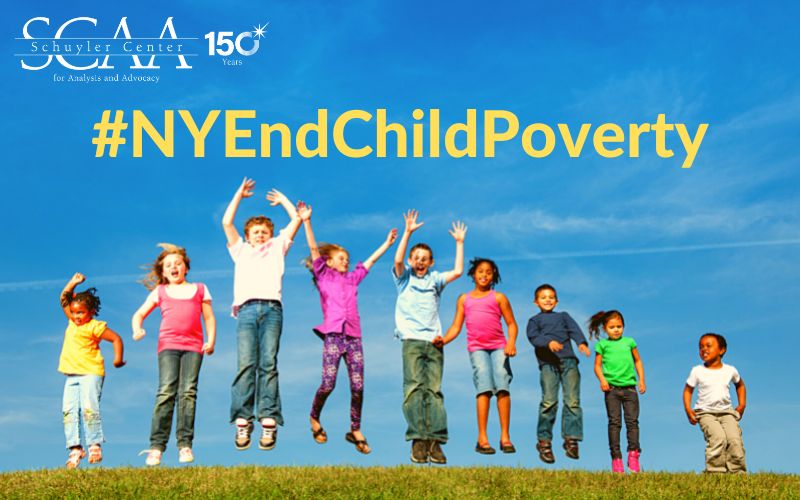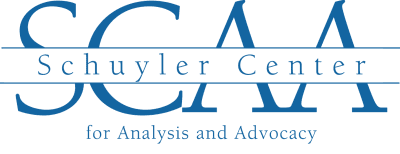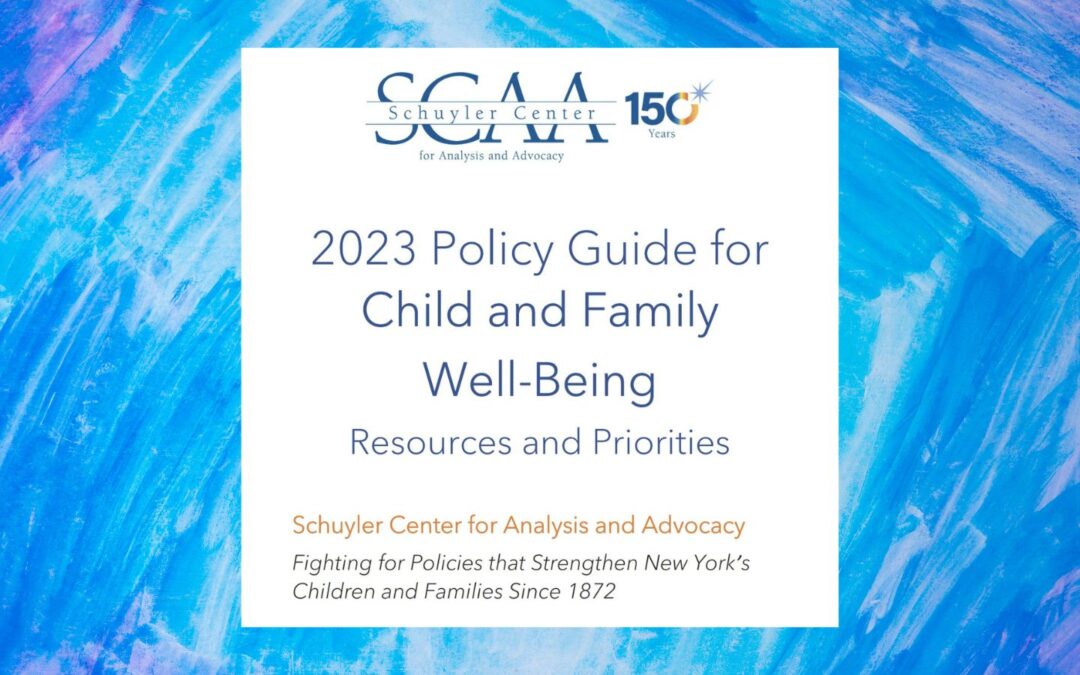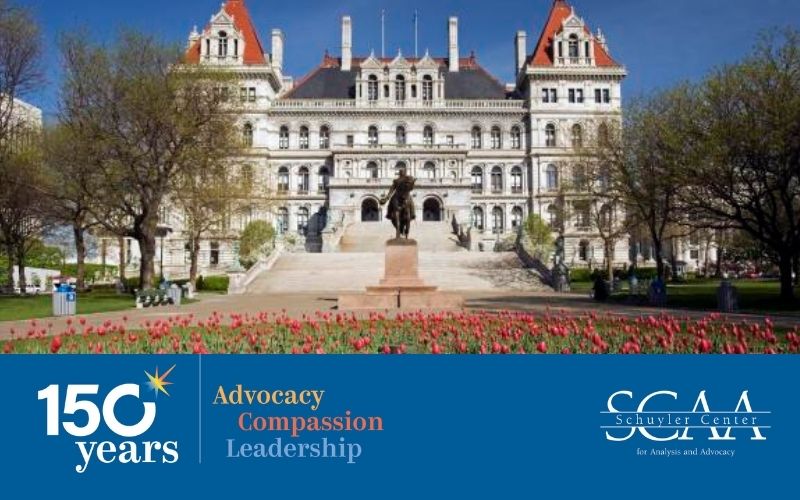
Child Poverty Action Needed in This Year’s Budget: Letter to NYS Legislators
More than 80 organizations have signed the letter below, which was sent to the full NYS Legislature (PDF version available here). The letter articulates key budget actions to begin to cutting child poverty. In 2021, New York passed the Child Poverty Reduction Act, committing the State to reducing child poverty by 50% over the next decade. On Tuesday, March 7, New York’s Child Poverty Reduction Advisory Council will assess the Executive Budget’s impacts on child poverty; the livestream and recording will be on the Office of Temporary and Disability Assistance website.
——-
March 6, 2023
Dear Legislator:
The 2023-24 State Budget provides an opportunity to change New York’s trajectory on child poverty. Child poverty in New York State continues to exceed the national rate, as it has for more than a decade. But it’s not hopeless: there are budget and policy solutions that can be implemented this year.
In 2021-22, the Legislature passed and New York enacted landmark legislation, the New York State Child Poverty Reduction Act, committing New York State to cutting child poverty in half in a decade. The Act had near-unanimous, bipartisan support from upstate, downstate, rural, urban, and suburban legislators and constituents. New York must take meaningful steps this year to make good on its promise.
One of the key learnings of the last three years is that government policy can make a real and immediate difference for people struggling to make ends meet. Pandemic-era supports confirmed that it is possible to quickly and sharply cut child poverty and boost family economic security. The most dramatic example was the temporary pandemic expansion of the Federal Child Tax Credit in 2021, which contributed to a 46% decline in child poverty nationwide.
The National Academies of Science, Engineering, and Medicine’s (NASEM) Roadmap to Reducing Child Poverty identifies several evidence-informed policies that can move the needle on child poverty, noting that there is not one single policy solution, but a combination of policies that, taken together, can turn the tide on child poverty.
With that in mind, there are critical, evidence-informed actions that can be taken in this year’s Budget that will immediately assist New York’s children and families:
- Deliver tax relief to children in low-income families by strengthening refundable tax credits. Specifically,
- add a robust credit for children under age four, currently excluded from New York’s Empire State Child Credit (ESCC) (S.771/A.2464 and S.4952/A.3911);
- ensure the full credit goes to the lowest-income families, by ending regressive minimum income requirements and phase-ins (S.771/A.2464);
- increase the credit amount to provide families meaningful support (S.771/A.2464 and S.4952/A.3911); and
- make the Earned Income Tax Credit EITC available to immigrant tax filers.
The Working Families Tax Credit (S.2077/A.4022) would accomplish all of these. The Governor’s Budget proposes nothing for the ESCC or EITC, though it does propose tax expenditures in other areas.
2. Increase New York’s minimum wage and adjust it each year to keep up with rising costs (S.1978-A/A.2204-A). The failure of the minimum wage to keep up with rising costs of living contributes to economic insecurity for families. Increased household income is associated with improved birth outcomes and reduced infant mortality and fewer child maltreatment reports. In 2020, there were 630,000 New York children living in a household with someone earning less than $15 per hour. More than a quarter of affected workers are parents (27.9%) and almost half of those are single parents (47.9%) who will see their earnings increase from the higher minimum wage. The Raise the Wage Act (S.1978-A/A.2204-A), would raise the minimum wage to $21.25 in NYC, Westchester, and LI and $20 upstate by 2026. In 2027, upstate would reach parity with the rest of the state, as the minimum wage would automatically increase each year. The Act would give 2.9 million workers an average raise of $63 per week, and could greatly reduce child poverty across New York State. The Governor’s budget proposes automatic increases to the minimum wage, once it reaches $15/hour under existing law, with caps on the increases, delivering a raise of about $13 per week for the average affected worker.
3. Keep children and families housed by establishing the Housing Access Voucher Program (HAVP) (S.568-A/A.4021), a state-level voucher program to provide housing stability to New York families at risk of homelessness. Housing in New York costs more than twice the national average and nearly one-third of households with children were behind on rent in November 2022. Voucher programs have been shown to lower rent burdens, prevent eviction, and reduce the risk of homelessness. Notably, children who grow up in households with vouchers have increased earnings in their 20s and lower incarceration rates. Stable housing is foundational to children’s well-being. A $250 million investment would serve 13,760 households, including nearly 4,000 families with children. The Governor’s budget does not include a Housing Access Voucher Program.
4. Establish and fund statewide, permanent Healthy School Meals for All to ensure all students receive a healthy school breakfast and lunch at no cost each school day. Nearly 600,000 children in New York State lack the food they need, and additional federal food assistance is slated to end in March 2023. Providing free meals for all students—regardless of income—is a proven strategy to reduce food insecurity, improve mental and physical health, support students’ ability to thrive academically, and bolster equity. With an investment of $200 million, more than 726,000 children will eat healthy meals at school, cost-free. The Governor’s budget did not propose funding for free school meals.
The New York State Comptroller’s recent report on poverty in our state is a sobering reminder that for too long, New York has allowed millions of New Yorkers, among them hundreds of thousands of children, to experience the hardships of poverty—at a much higher rate than our neighboring states and the nation as a whole. Child poverty has lasting impacts on our children, families, and communities, and disproportionately harms young children, Black and Latinx children, and children in immigrant families. Columbia University researchers estimate child poverty costs New York more than $60 billion per year. The Child Poverty Reduction Act and Advisory Council have built a strong foundation for New York to significantly reduce child poverty in our state.
By taking the concrete steps outlined above in this year’s budget, the Legislature can build on that foundation and immediately bolster family economic security, child well-being, and racial equity throughout New York State.
Sincerely,
Schuyler Center for Analysis and Advocacy
Advocate for Westchester Youth
ALIGN: The Alliance for a Greater New York
Alliance for Quality Education
American Academy of Pediatrics, NYS
Candace Cabral, Child Poverty Reduction Advisory Council Member
Cattaraugus Community Action, Inc.
Center for NYC Affairs, The New School
Chautauqua Opportunities Inc.
Children’s Defense Fund
Children’s Health Fund
Children’s Village
Chilis on Wheels
Church Women United in New York State
Churches United for Fair Housing (CUFFH)
Citizens’ Committee for Children
City of Peekskill Youth Bureau
Colgate Rochester Crozer Divinity School
Community Food Advocates
Community Health Care Association of New York State
Community Service Society
CUNY Urban Food Policy Institute
Early Care & Learning Council
Economic Opportunity Council of Suffolk, Inc.
Equipping Saints to Serve Ministries
Equity Advocates
Expecting Relief
Families Together in New York State
Feeding New York State
Feeding Westchester
Finger Lakes Performing Provider System
Foodlink
For the Many
FPWA
Free the People WNY
God’s Love We Deliver
Greater Rochester Chamber of Commerce
Greenburgh Eleven UFSD
Health and Welfare Council of Long Island
Healthi Kids Coalition
Hope’s Door
Hunger Solutions New York
JCEO
Mohawk Valley Community Action Agency, Inc.
National Employment Law Project
New York Communities for Change
New York Immigration Coalition
New York State Community Action Association
Newburgh Urban Farm and Food Initiative
Northeast NY Coalition for Occupational Safety and Health
Northern Rivers
Partnership for the Public Good
Poppy Muse, Inc.
Prevent Child Abuse NY
Robin Hood
Rochester Housing Authority
Rochester-Monroe Anti-Poverty Initiative (RMAPI)
Rural Health Network of SCNY, Inc.
Schenectady Community Action Program
Sister to Sister International
Strong Economy for All Coalition
The Bridge Project
The Children’s Agenda
The Education Trust New York
The Legal Aid Society
The New York State CASA Association, Inc.
The STEM Alliance
Tompkins County Workers’ Center
United Community Center of Westchester, Inc.
United Way of Greater Rochester and the Finger Lakes
United Way of the Greater Capital Region
United Way of Westchester and Putnam
University of Rochester Department of Pediatrics
Urban Outreach Center
Vegan Activist Alliance
Wellness in the Schools
Westchester Children’s Association
Westchester Library System
Westchester Women’s Agenda
WNY Women’s Foundation
Worker Justice Center of New York
Wyoming County Community Action
Youth Shelter Program of Westchester
YWCA White Plains & Central Westchester





Recent Comments